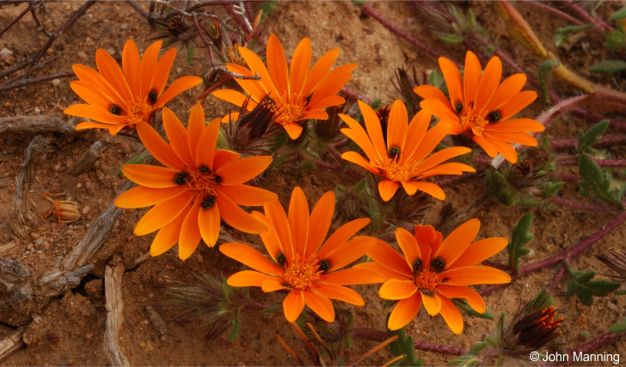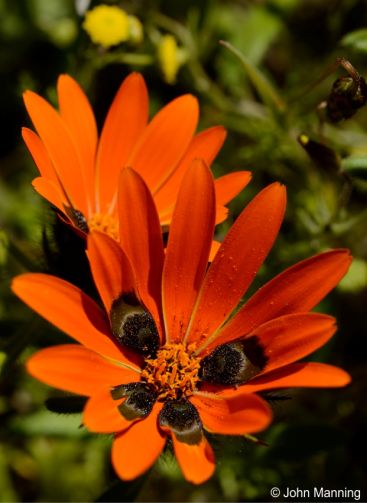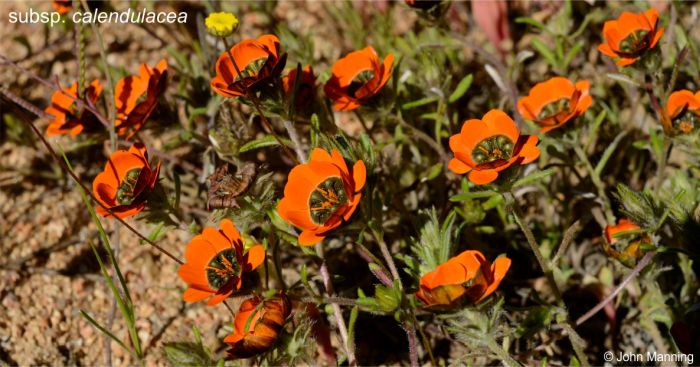Gorteria diffusa
Gorteria diffusa Thunb.
Family: Asteraceae
Common names: beetle daisy (Eng.); katoog (Afr.)
Introduction
Commonly known as the beetle daisy, Gorteria diffusa is characterised by intricate dotted patterns on the ray florets, placed around the central disk of the flower head. These dots reflect light and resemble the shiny bodies of the bee fly, Megapalpus nitidus. They are strategically placed to lure these social insects to the blooms, where they collect nectar and pollen and inadvertently transfer pollen among flowers during subsequent visits.

Description
Description
Gorteria diffusa is a winter-growing annual, typically reaching heights of 50 to 300 mm. Its growth habit is sprawling from the base, characterized by a slender taproot and numerous fibrous lateral roots. The stems are cylindrical, diffusely branched, hairy and often purplish. The leaves are variable, linear, lanceolate or oblanceolate and arranged alternately, measuring 20 to 50 mm in length and 5 to 8 mm in width. The leaves taper below. They are bright green, with a hairy upper surface and a woolly lower surface, and the margins are typically entire but sometimes toothed or pinnatifid, and revolute. The capitula are radiate, solitary, sessile, and terminal, with diameters ranging from 20 to 35 mm. The involucre is ovoid, with acuminate, sharply pointed bracts that are hairy toward the tips, united at the base into an urn-shaped cup. The involucre encloses the fruits after flowering. The ray florets are ligulate and sterile, the ligules measuring 12 to 20 mm in length and 4 to 6 mm in width, narrowed at the base. The ligules are orange above and dull purplish below, typically featuring a dark basal, glossy spot on one to all of the florets, each with a small white reflective dot. The 5-lobed disc florets are orange, with outer florets mostly female-fertile, and inner florets male. The anthers are shortly sagittate at the base, with an ovate apical appendage. The style is subglobose at the base, with linear-lanceolate branches. The cypselas are obovoid, silky towards the tip. The pappus consists of minute scales hidden among the cypsela hairs. The cypselas germinate within the closed involucre (Duncan & Ellis 2011). Flowering time is from midwinter to spring, July to October, with a peak in August and September.

Conservation Status
Status
Least Concern (LC), Gorteria diffusa is widespread and common and not in danger of extinction (Mtshali 2023).
Distribution and habitat
Distribution description
Gorteria diffusa has a wide geographic range in the winter rainfall regions of southern Africa, from southern Namibia through the Richtersveld, Namaqualand and the Western Karoo to the western, southwestern, and southern areas of the Western Cape in South Africa (Roessler 1959). It grows on clay and sandy flats or stony lower slopes (Snijman 2013).
Derivation of name and historical aspects
History
The genus name Gorteria honours the Dutch botanist and physicist duo, Johannes and David de Gorter, a father and son renowned for their contributions to the field of botany. Gorteria diffusa itself was collected and named by the Swedish botanist C.P. Thunberg during the 18th century from an unrecorded locality in the Cape region (Thunberg 1800). The type specimen is held at Uppsala University in Thunberg’s personal herbarium. The epithet diffusa refers to the diffuse or spread-out habit of this plant. The beetle daisy derives its common name from the raised spots on the ray florets that resemble small beetles.
Gorteria diffusa was previously divided by Roessler (1959, 1973), into three subspecies: subsp. diffusa, subsp. calendulacea and subsp. parviligulata. This taxonomy has recently undergone significant changes following the phylogenetic analysis of the genus by Stångberg et al. (2013). Their study retrieved three distinct evolutionary lineages in G. diffusa with different distributions. Populations of Gorteria diffusa from the south grouped with Gorteria personata subsp. gracilis and are now included with it as the species G. piloselloides. Gorteria diffusa subsp. parviligulata was recognised as a distinct species under the name G. parviligulata. The northern populations of G. diffusa, including G. diffusa subsp. calendulacea, were included with typical G. diffusa (Stångberg & Anderberg 2014).

Ecology
Ecology
Recent research has shown that the so-called beetle-marks on the florets mimic female bee flies in the genus Meagapalpus, leading to visits from male bee flies (Johnson & Midgley 1997; Ellis & Johnson 2009). While investigating these decoy female flies in the flower heads, the male bee flies pick up pollen which they carry to other flower heads, thus inadvertently pollinating the flowers. The beetle daisy typically thrives in regions with winter rainfall. It is well-suited to dry, sunny climates and is often found in rocky or sandy habitats.
Uses
Use
No medicinal or cultural uses are known. Gorteria diffusa could be used as part of a spring-flowering annual plant display.
Growing Gorteria diffusa
Grow
Beetle daisy is rarely cultivated due to its high sensitivity to soil moisture and air humidity, making both seedlings and mature plants prone to rapid fungal infections. It thrives in full sun and dry atmospheres, making it suitable for mass planting, rock garden pockets or in troughs and window boxes filled with gritty soil. For successful cultivation, mature plants and seedlings should be allowed to nearly wilt before the next watering, ensuring a dry period between waterings. Cypselas (seeds) are best sown just below the soil surface in autumn, in a well-drained sandy-gritty medium, in a protected location with ample sunlight. Germination can be sporadic, with only a few cypselas sprouting initially, while others may remain dormant for one or more seasons. Under ideal conditions, seedlings can reach the flowering stage in three to four months. Despite its diminutive size, Gorteria diffusa can bring charm to any garden setting (Hussey et al. 1997).
References
- Duncan, G.D. & Ellis, A.G. 2011. Gorteria diffusa. Curtis’s Botanical Magazine 28(4):341-348.
- Ellis, A.G. & Johnson, S.D. 2009. The evolution of floral variation without pollinator shifts in Gorteria diffusa (Asteraceae). American Journal of Botany 96:793–801.
- Funk, V.A. & Chan, R. 2008. Phylogeny of spiny African daisies (Compositae, Arctodeae, subtribe Gorteriinae) based on trnL-F, ndhF, and ITS sequence data. Molecular Phylogenetics and Evolution 48: 47–60.
- Hussey, B.M.J., Keighery, G.J., Cousens, R.D, Dodd, J & Llody, S.G. 1997. Western Weeds. A guide to the weeds of Western Australia. Plant Protection Society of Western Australia, Perth.
- Johnson, S. & Midgley, J. 1997. Fly pollination of Gorteria diffusa (Asteraceae), and a possible mimetic function for dark spots on the capitulum. American Journal of Botany 84(4):489.
- Karis, P.O., Funk, V.A., McKenzie, R.J., Barker, N.P & Chan, R. 2009. Arctotideae. In: Funk, V.A., Susanna, A., Stuessy, T.F & Bayer, R.J. (eds). Systematics, Evolution and Biogeograpgy of Compositae. International Association for Plant Taxonomy, Vienna.
- Mtshali, H. 2023. Gorteria diffusa Thunb. National Assessment: Red List of South African Plants version . Accessed on 2024/07/19.
- Roessler, H. 1959. Revision der Artotidae – Gorteriinae (Compositae). Mitteilungen der Botanischen Staatssammlung Muchen 3:364–418
- Roessler, H. 1975. The Compositae of the Flora Zambesiaca Area, 5 Subtribe Gorteriinae. Kirkia 10(1):73-99.
- Snijman, D.A. (ed.). 2013. Plants of the Greater Cape Floristic Region 2: The Extra Cape Flora. Strelitzia 30. South African National Biodiversity Institute, Pretoria.
- Stångberg, F. & Anderberg, A.A. 2014. Morphology and taxonomic reclassification of Gorteria (Asteraceae). Willdenowia 44(1):97-120.
- Stångberg, F., Ellis, A.G. & Anderberg, A.A. 2013. Evolutionary relationships in Gorteria: A re-evaluation. Taxon 62(3):537-549.
- Thunberg, C.P. 1800. Prodromus Plantarum Capensium, part 2. Edman, Uppsala.
- Tropical Plant Encyclopedia. Gorteria diffusa. https://toptropicals.com/catalog/uid/gorteria_diffusa.htm. Accessed 19/07/24.
Credits
Khanya Ntondini
Compton Herbarium
August 2024
Acknowledgements: images by John Manning.
Plant Attributes:
Plant Type: Bi/Annual
SA Distribution: Northern Cape, Western Cape
Soil type: Sandy, Clay, Loam
Flowering season: Spring, Winter
PH: Acid, Neutral
Flower colour: Black, Yellow, Orange
Aspect: Full Sun
Gardening skill: Challenging
Special Features:
Horticultural zones








Rate this article
Article well written and informative
Rate this plant
Is this an interesting plant?
Login to add your Comment
Back to topNot registered yet? Click here to register.